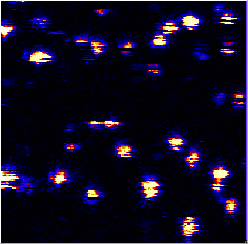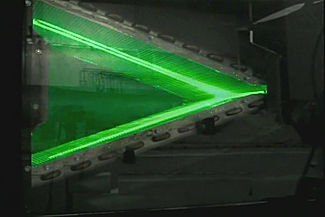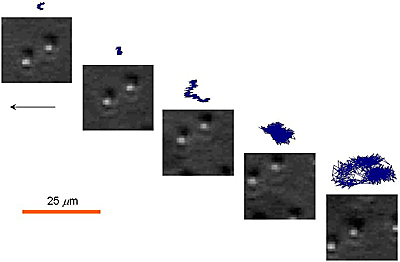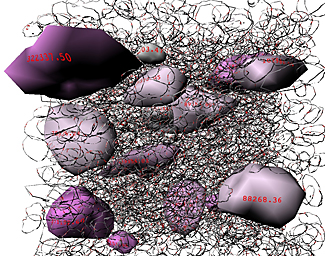| January 23, 2008

[NIST Tech Beat Search] [Credits] [NIST Tech Beat Archives] [Media Contacts] [Subscription Information]

JILA Solves Problem of Quantum Dot ‘Blinking’
 |
JILA scientists have found a way to suppress the blinking problem in quantum dots by bathing them in a chemical solution. This animated image, which demonstrates the basic blinking phenomenon, is made from a series of 40 images taken about one minute apart. Quantum dots actually blink on time scales ranging from millionths of a second to tens of seconds or longer.
Credit: K Kuno/JILA |
Quantum dots—tiny, intense, tunable sources of colorful light—are illuminating new opportunities in biomedical research, cryptography and other fields. But these semiconductor nanocrystals also have a secret problem, a kind of nervous tic. They mysteriously tend to “blink” on and off like Christmas tree lights, which can reduce their usefulness.
Scientists at JILA have found one possible way to solve the blinking problem and have induced quantum dots to emit photons (the smallest particles of light) faster and more consistently. The advance could make quantum dots more sensitive as fluorescent tags in biomedical tests and single-molecule studies and steadier sources of single photons for “unbreakable” quantum encryption. JILA is a joint venture of the National Institute of Standards and Technology (NIST) and the University of Colorado at Boulder.
By bathing the dots in a watery solution of an antioxidant chemical used as a food additive, the JILA team increased photon emission rate four- to fivefold, a “shocking” result because the rate at which light radiates is generally considered an immutable property of the dot, JILA/NIST Fellow David Nesbitt says. The JILA scientists dramatically reduced the average time delay between excitation of a quantum dot and resulting photon emission from 21 nanoseconds to 4 nanoseconds while reducing the probability of blinking up to 100 fold. Nesbitt calls blinking the “hidden dirty secret” of quantum dots. (Nesbitt notes that blinking is not always an annoyance. For example, it can serve as a measurement probe of very slow rates of electron flow through nanoscale materials).
The quantum dots used in the JILA experiments were made of cadmium-selenide cores just 4 nanometers wide coated with zinc sulfide. When a dot is excited by a brief laser pulse, one electron is separated from the “hole” it normally occupies. A few nanoseconds later, the electron typically falls back into the hole, sometimes producing a single photon—always in a color that depends on dot size, greenish-yellow in this case. But every so often the electron fails to make it back to its hole and instead is ejected to imperfections on the dot’s surface. The chemical added at JILA apparently attaches to these imperfections, blocking the electron from being trapped and thereby preventing the dot from blinking off.
The JILA research was funded in part by the National Science Foundation and NIST.
* V. Fomenko and D. J. Nesbitt. Solution control of radiative and nonradiative lifetimes: a novel contribution to quantum dot blinking suppression. Nano Letters. Published online Dec. 21, 2007.
Media Contact: Laura Ost, laura.ost@nist.gov, (303) 497-4880 

NIST Helps Heat Pumps ‘Go With the Flow’ to Boost Output
 |
A sheet of laser light illuminating the surface of the heat exchanger during the air velocity measurement experiment.
Credit: NIST
View hi-resolution image |
Air-source heat pumps typically deliver 1 1/2 to three times more heating energy to a home than the electric energy they consume. This is possible because heat pumps move heat rather than convert it from a fuel (as combustion heating systems do). National Institute of Standards and Technology (NIST) researchers are working to improve the performance of these energy superstars even further by providing engineers with computer-based tools for optimizing heat exchanger designs.
In a typical air-source heat pump, air flows over two refrigerant-filled heat exchangers (known as coils): one indoor and the other outdoor, both of which have metal fins to aid heat transfer. In the heating mode, liquid refrigerant within the outside coil extracts heat from the air and the refrigerant evaporates into a gas. The indoor coil releases heat from the refrigerant as it condenses back into a liquid. A valve near the compressor can change the direction of the refrigerant flow for cooling.
Performance of air-to-refrigerant heat exchangers can be reduced by uneven air flow distribution. However, performance degradation can be significantly avoided by design changes that increase refrigerant flow in areas that receive more air. To achieve this, one must ascertain the actual air distribution in a given system.
NIST researchers have developed a testing apparatus that uses a high-resolution camera to track—with laser-illuminated dust particles—the motion and distribution of air flow in finned-tube heat exchangers. Data from these highly accurate laboratory experiments are being compared with computer simulations of air flow performed with computational fluid dynamics (CFD) software. Once accurate CFD models are developed and validated, engineers could use them as the basis for design changes to coil assemblies and refrigerant circuitries to accommodate the existing air distribution.
The NIST program, partially sponsored by the Air-Conditioning and Refrigeration Technology Institute (ARTI) under a Cooperative Research and Development Agreement (CRADA), could increase finned-tube heat exchanger heating or cooling capacity by five percent, resulting in improved heat pump efficiency. Additionally, such improvements could allow manufacturers to reduce the heat exchanger size, thereby reducing material cost and the amount of refrigerant needed. The NIST study results on home air-source heat pumps will be issued in 2009 and are also expected to be applicable to large heat exchangers used in commercial buildings and refrigeration systems.
For further information, go to www.bfrl.nist.gov/863/HVAC
Media Contact: John Blair, john.blair@nist.gov, (301) 975-4261 

Videos Extract Mechanical Properties of Liquid-Gel Interfaces
 |
Microscopic beads embedded in a gel surface were used to trace the motion of a gel forming an interface with a liquid. As the gel/liquid interface was stirred, the beads followed a complicated trajectory (patterns above photos), which the researchers broke down into a range of small, fast movements to large, slow movements in order to determine the gel's underlying mechanical properties. As the strength of the flow is increased (from left to right), the scale of the motion increases.
To see a movie of the recorded motion, click here.
Credit: NIST |
Blood coursing through vessels, lubricated cartilage sliding against joints, ink jets splashing on paper—living and nonliving things abound with fluids meeting solids. However important these liquid/solid boundaries may be, conventional methods cannot measure basic mechanical properties of these interfaces in their natural environments. Now, researchers at the National Institute of Standards and Technology (NIST) and the University of Minnesota have demonstrated a video method that eventually may be able to make measurements on these types of biological and industrial systems.*
Optical microrheology—an emerging tool for studying flow in small samples—usually relies on heat to stir up motion. Analyzing this heat-induced movement can provide the information needed to determine important mechanical properties of fluids and the interfaces that fluids form with other materials. However, when strong flows overwhelm heat-based motion, this method isn't applicable.
Motivated by this, researchers developed a video method that can extract optically basic properties of the liquid/solid interface in strong flows. The solid material they chose was a gel, a substance that has both solid-like properties such as elasticity and liquid-like properties such as viscosity (resistance to flow).
In between a pair of centimeter-scale circular plates, the researchers deposited a gel of polydimethylsiloxane (a common material used in contact lenses and microfluidics devices). Pouring a liquid solution of polypropylene glycol on the gel, they then rotated the top plate to create forces at the liquid/gel interface. The results could be observed by tracking the motion of styrene beads in the gel.
The researchers discovered that the boundary between the liquid and gel became unstable in response to “mechanical noise” (irregularities in the motion of the plates). Such “noise” occurs in real-world physical systems. Surprisingly, a small amount of this mechanical noise produced a lot of motion at the fluid/gel interface. This motion provided so much useful information that the researchers could determine the gel’s mechanical properties—namely its “viscoelasticity”—at the liquid/gel interface.
The encouraging results from this model system show that this new approach could potentially be applied to determining properties of many useful and important liquid/solid interfaces. The NIST/Minnesota approach has possible applications in areas as diverse as speech therapy where observing the flow of air over vocal cords could enable noninvasive measures of vocal tissue elasticity and help clinicians detect problems at an early stage. Also, this research may help clarify specific plastics manufacturing problems, such as “shear banding,” in which flow can separate a uniformly blended polymer undesirably into different components.
* E.K. Hobbie, S. Lin-Gibson, and S. Kumar Non-Brownian microrheology of a fluid-gel interface, To appear in Physical Review Letters.
Media Contact: Ben Stein, bstein@nist.gov, (301) 975-3097 

NIST Building Facility for Hydrogen Pipeline Testing
Efforts to create a “hydrogen economy” to reduce U.S. oil imports will get a boost from a new laboratory at the National Institute of Standards and Technology (NIST) that will evaluate tests, materials, mechanical properties and standards for hydrogen pipelines.
Construction is just beginning on the 750-square-foot laboratory on the site of a former hydrogen test facility at the NIST campus in Boulder, Colo. The laboratory—including a control room in a separate, existing building—is expected to be operational by mid-2008.
Widely used in industrial processing, hydrogen is attractive as a fuel because it burns cleanly without carbon emissions and can be derived from domestic sources. But long-term exposure to hydrogen can embrittle existing pipelines, increasing the potential for dangerous failures. NIST researchers will use the hydrogen laboratory to develop long-term service tests and apply them to study pipeline materials and mechanical effects. NIST is coordinating its research and safety plans with other national laboratories and industry groups working with hydrogen.
Experiments will involve immersing pipeline materials in pressurized hydrogen gas contained in steel alloy test chambers. The largest of these—about the size of a small automobile gas tank—will be the nation’s biggest hydrogen test chamber. Studies will be conducted using hydraulic machines to test mechanical fatigue, large frames for applying pressure to pipeline materials and equipment for testing properties such as tensile and residual strength and fracture toughness.
Tom Siewert, the NIST metallurgist who will manage the new laboratory, says the initial research will involve collecting fatigue and fracture data for existing pipelines as a baseline and conducting “round robin” exercises to assess the consistency of tests among various hydrogen laboratories. In the future, the focus will expand to new pipeline materials such as composites.
To help develop the research program, NIST recently held a workshop involving 46 participants representing pipeline owners, industry and standards organizations, academic researchers, national laboratories and government agencies. Working groups identified priority needs in materials; test techniques and methods; and codes, standards and safety. The proceedings are available online at www.boulder.nist.gov/div853/Pipeline_Workshop/index.htm., or on a compact disc available on request from Siewert, thomas.siewert@nist.gov, (303) 497-3523.
The new laboratory is among a variety of NIST programs focusing on hydrogen, including studies on fuel cells. More information is available at www.nist.gov/hydrogen.
Media Contact: Laura Ost, laura.ost@nist.gov, (303) 497-4880 

Concrete Flow Researchers to Use Argonne Supercomputer
 |
A nonphotorealistic image from a computer simulation showing 2,025 rocks. Rocks with high stress values are colored solid and have their stress values painted on the surface. The remaining rocks are displayed as outlines.
Visualization provided by Marc Olano and Steven Satterfield, NIST
View hi-resolution image |
The Argonne National Laboratory of the Department of Energy (DoE) announced on Jan. 17, 2008, that a team of researchers at the National Institute of Standards and Technology (NIST) has been awarded 750,000 central processing unit (CPU) hours on the IBM Blue Gene/P supercomputer at the Argonne Leadership Computing Facility. The allocation is one of 55 awards of supercomputer time given in a peer-reviewed competition known as the Innovative and Novel Computational Impact on Theory and Experiment (INCITE) program.
The NIST team of William George, Judith Terrill, Nicos Martys, John Hagedorn and Edward Garboczi will use the granted time to study the flow, dispersion and merging of densely suspended, diversely sized and shaped materials (primarily cement in concrete) under a variety of conditions. Access to the Argonne machine will allow computer modeling at a level and range impossible with existing facilities at NIST. The ability to better model real conditions will significantly improve the scientific basis for prediction and measurement of the flow properties of concrete.
A DoE Web site on the award is at www.sc.doe.gov/ascr/incite/index.html.
Media Contact: Michael E. Newman, michael.newman@nist.gov, (301) 975-3025


Quick Links
NIST Radio Station WWVH Gets Antenna Makeover
Radio station WWVH in Hawaii, operated since 1948 by the National Institute of Standards and Technology (NIST) to broadcast time, frequency and other announcements, recently powered up innovative replacement antennas. NIST has installed new antennas encased in fiberglass instead of traditional steel supports to resist corrosion from the salty ocean air. The fiberglass design will reduce maintenance and repair costs as well as climbing hazards to staff. Users of the radio broadcast service may notice reduced signal down-time.
NIST time and frequency experts believe the project is the first demonstration of high-powered, high-frequency fiberglass antennas on land. For more information, go to www.nist.gov/public_affairs/factsheet/wwvh_antenna.html.
March Conference Explores Building Trust on the Internet
Establishing trust in Internet transactions is a mutual process between user and service provider. In bank transactions, for example, customers want to be sure that their browser is taking them to their bank and not to a fake website. For its part, the bank needs to verify that the logged-in user is their customer and not an imposter. An upcoming conference co-sponsored by the National Institute of Standards and Technology (NIST) will feature the latest technical information on establishing trust on the Internet. Known as IDtrust 2008, the conference will be held March 4-6, 2008, at NIST’s Gaithersburg campus.
Previously known as the PKI R&D Workshop, the conference covers a broad set of Internet-based identity and trust tools and explores the possibility of creating an “identity layer,” a method of managing identity information that would be woven into the general Internet infrastructure. Intended for government, academia and industry alike, the conference will include peer-reviewed papers and discussions among panels of invited experts.
Registration for the conference closes on Feb. 26, 2008, with a lower registration fee available through Jan. 26, 2008. For more information, go to www.nist.gov/public_affairs/confpage/080304htm.htm.
|

